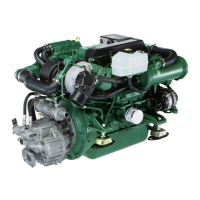Engine room, ventilation and sound proofing
110
Make sure the necessary room is available for service
and repair. Also make sure that all hatches are proper-
ly sealed off.
Soundproofing
The drive package must be installed in such a way as
to minimise noise and vibration. The noise that occurs
is airborne noise and structural noise (vibration).
Structural noise
Vibration from the engine is transmitted via the engine
mountings and the engine bed to the hull. Other routes
are via the transmission and propeller systems, ex-
haust pipe, coolant pipes, fuel pipes, electrical cables
and control cables.
Pressure pulses from the propeller are transmitted
through the water and into the hull. Pulsed force on
the propeller enters the hull via support blocks, bear-
ings and seals.
Airborne noise
This section refers to airborne noise from the engine
bay. The most important measure to lower airborne
noise from the engine room is to seal the room proper-
ly. Further improvements in noise level reduction can
be achieved by sound insulation material and by de-
signing sound traps for the air inlets.
The engine installation should be soundproofed in or-
der to obtain a noise level that is as low as possible.
Build the engine compartment with sound traps. Differ-
ent types of sound traps can be selected. The figure
reflects a type that is also provided with drainage.
Furthermore, due consideration must be given to the
thickness of the insulation material.
Prior to installing the insulation material, make sure
that there is sufficient room for checking, service and
repair and for the engine movements during operation.
Also make sure that all hatches are properly sealed
off.
Greatest possible care must be given to the task of
screening the sound source as well as possible.
Screen all the way down to the hull but leave a small
distance to prevent bilgewater from penetrating insula-
tion material.
Cracks, openings etc. must be carefully sealed off
with insulation material. In cases where the engine is
installed under the floor, dress all bulkheads and floor-
boards.

